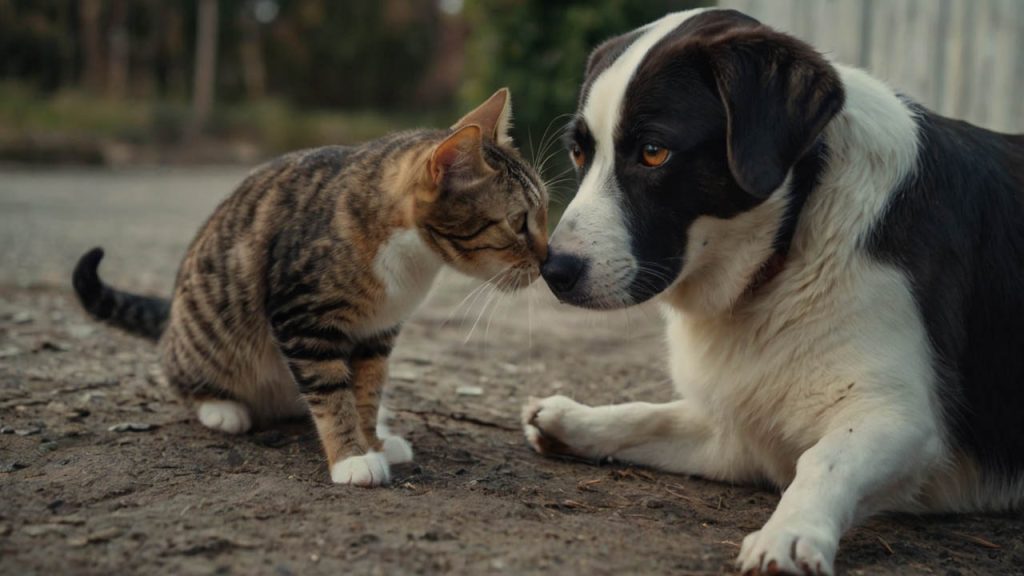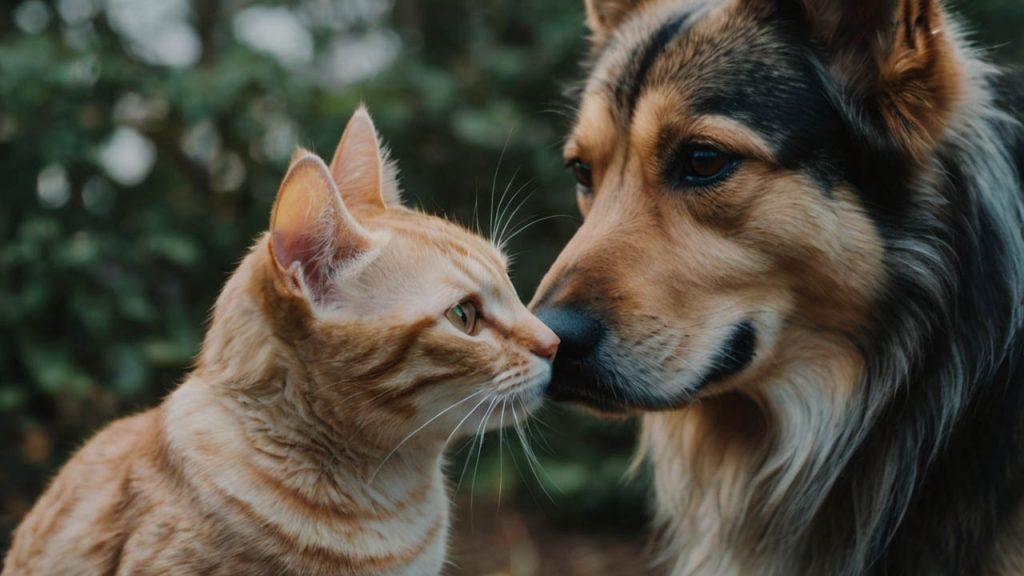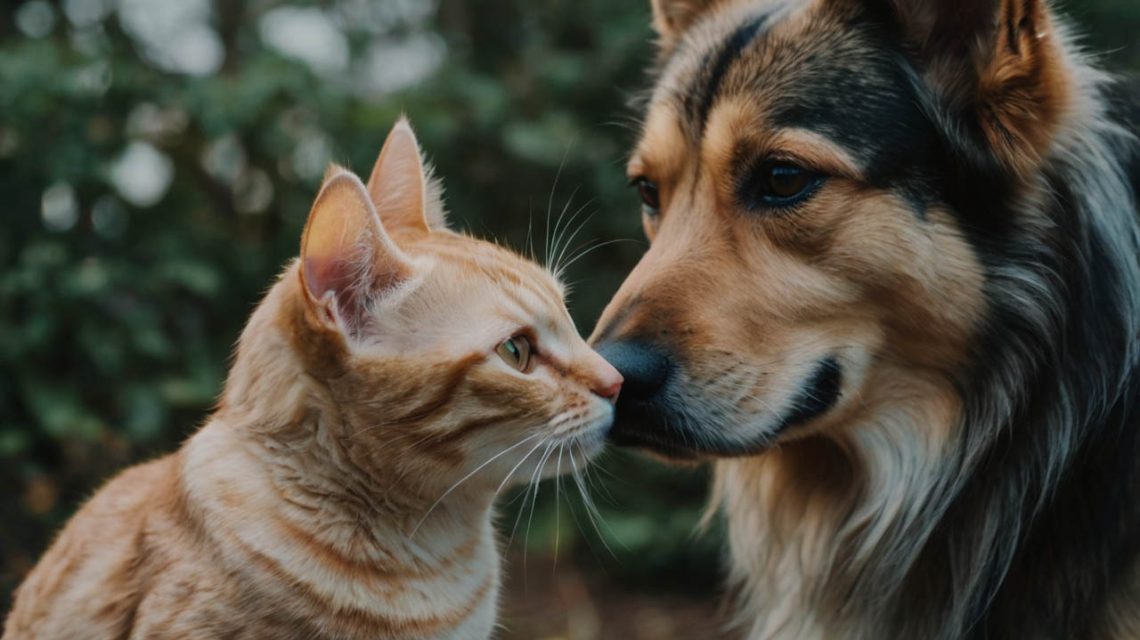Introduction: Creating Harmony Between Dogs and Cats
Learning how to introduce dogs to cats properly can transform a potentially stressful situation into the beginning of a beautiful interspecies friendship that enriches your entire household. According to the American Pet Products Association, approximately 12% of U.S. households have both dogs and cats, proving that these traditionally opposing species can indeed live together harmoniously. Moreover, research from the Journal of Veterinary Behavior indicates that when pet owners understand how to introduce dogs to cats correctly, the success rate for peaceful coexistence exceeds 80% within the first three months.
The process of discovering how to introduce dogs to cats requires patience, planning, and understanding of both species’ natural instincts and communication styles. Studies conducted by animal behaviorists at Cornell University’s College of Veterinary Medicine demonstrate that failed introductions often result from rushing the process or misreading animal body language rather than inherent incompatibility. Furthermore, successful introductions depend on factors including the animals’ ages, previous experiences, and individual personalities, making a customized approach essential for each unique situation.
Understanding how to introduce dogs to cats involves more than simply putting two animals in the same room and hoping for the best. Each species communicates differently, perceives threats uniquely, and requires specific environmental conditions to feel secure during initial meetings. Therefore, this comprehensive guide provides scientifically-backed strategies, step-by-step protocols, and troubleshooting techniques to ensure your dog and cat develop a positive relationship that lasts a lifetime.
Why Learning How to Introduce Dogs to Cats Matters
Understanding Natural Instincts and Behaviors
Before implementing how to introduce dogs to cats, recognizing each species’ inherent behaviors proves crucial for success. Dogs, as pack animals, naturally seek social hierarchy and may view cats as prey, playmates, or pack members depending on their breed and socialization. Subsequently, herding breeds might chase cats due to ingrained instincts, while companion breeds often adapt more readily to feline housemates.
Cats approach new situations differently when learning how to introduce dogs to cats properly. As both predator and prey animals, cats maintain heightened alertness and prefer controlling their environment. Furthermore, cats communicate through subtle body language that dogs often misinterpret, leading to misunderstandings that escalate into conflict without proper management.
The prey drive significantly impacts how to introduce dogs to cats successfully. Terriers, sighthounds, and hunting breeds possess stronger prey drives that require careful management during introductions. Research shows that dogs with high prey drive can learn to coexist with cats through proper conditioning, though the process typically requires 2-3 times longer than with low-prey-drive breeds.

Benefits of Successful Multi-Pet Households
Mastering how to introduce dogs to cats creates numerous benefits beyond simple coexistence. Multi-pet households report decreased anxiety and destructive behaviors in both species when animals form positive relationships. Moreover, cats and dogs living together harmoniously provide mutual companionship during owner absences, reducing separation anxiety by up to 60% according to veterinary behavioral studies.
Physical health improves when you properly execute how to introduce dogs to cats strategies. Cats in dog-friendly homes often become more active, helping combat obesity that affects 59% of domestic cats. Additionally, dogs with feline companions show reduced stress markers in cortisol testing, indicating improved emotional wellbeing.
Social development accelerates when young animals learn how to introduce dogs to cats early in life. Puppies raised with cats develop better impulse control and gentler play styles. Furthermore, kittens exposed to friendly dogs during their socialization period (2-7 weeks) show increased confidence and adaptability throughout their lives.
How to Introduce Dogs to Cats: Essential Preparation
Setting Up Your Home for Success
Proper environmental setup before learning how to introduce dogs to cats significantly increases success rates. Create separate living spaces with all necessary resources—food, water, litter boxes, and resting areas—for each pet. Subsequently, install baby gates to create visual barriers while allowing animals to observe each other safely.
Vertical space proves crucial when implementing how to introduce dogs to cats protocols. Install cat trees, shelves, or perches that allow cats to retreat upward when feeling threatened. Research indicates that cats with adequate vertical territory show 70% less stress during dog introductions compared to those limited to floor level.
Escape routes must exist throughout your home when practicing how to introduce dogs to cats. Ensure cats can access safe rooms where dogs cannot follow, using cat doors or high baby gates cats can jump over. Furthermore, never corner a cat during introductions, as trapped cats may attack even friendly dogs in self-defense.
Assessing Readiness for Introduction
Evaluating both animals before starting how to introduce dogs to cats prevents dangerous situations. Assess your dog’s prey drive through controlled exposure to cats at a distance, noting reactions like fixation, whining, or lunging. Moreover, dogs requiring extensive restraint or showing aggressive behaviors need professional intervention before proceeding.
Cat temperament significantly influences how to introduce dogs to cats successfully. Confident, dog-experienced cats typically adapt within 2-3 weeks, while shy or elderly cats may require months. Additionally, cats with previous dog trauma need extremely gradual introductions with possible veterinary behavioral support.
Health status affects readiness for how to introduce dogs to cats processes. Both animals should receive veterinary checkups ensuring they’re healthy enough for potentially stressful introductions. Furthermore, update vaccinations and parasite prevention, as stress can temporarily suppress immune function.
Step-by-Step Guide: How to Introduce Dogs to Cats
Phase 1: Scent Introduction
Beginning how to introduce dogs to cats with scent exchange allows safe initial contact. Rub a towel on each pet, then place it near the other’s feeding area. Subsequently, animals associate the new scent with positive experiences like eating, creating favorable first impressions.
Rotate living spaces as part of how to introduce dogs to cats scent familiarization. Allow your cat to explore dog-free areas where the dog normally stays, and vice versa. This investigation helps animals gather information about each other without direct confrontation.
Duration of scent introduction when learning how to introduce dogs to cats typically spans 3-7 days. Monitor each pet’s reaction to scented items, proceeding only when both show calm curiosity rather than aggression or fear. Furthermore, some animals require extended scent work lasting several weeks before progressing.
Phase 2: Visual Contact Through Barriers
Implementing visual contact in how to introduce dogs to cats requires careful management. Use baby gates or screen doors allowing animals to see each other while maintaining physical separation. Moreover, conduct these sessions during calm periods, avoiding times when either pet feels excited or stressed.
Distance matters significantly when practicing how to introduce dogs to cats visual introductions. Start with maximum distance where animals notice but don’t react strongly to each other. Gradually decrease distance over multiple sessions as comfort levels increase.
Positive associations during visual contact enhance how to introduce dogs to cats success. Feed special treats or meals within sight of each other, creating positive emotional connections. Additionally, engage in favorite activities like play or grooming during visual sessions, reinforcing that good things happen around the other pet.
Phase 3: Controlled Physical Meetings
First physical contact when executing how to introduce dogs to cats requires maximum control. Keep dogs leashed and allow cats freedom to approach or retreat. Furthermore, conduct initial meetings in neutral spaces rather than either pet’s primary territory.
Duration of initial meetings in how to introduce dogs to cats should remain brief—under 5 minutes. Multiple short positive sessions prove more effective than lengthy stressful encounters. Moreover, end sessions while both animals remain calm, preventing negative associations.
Two-person teams optimize how to introduce dogs to cats physical introductions. One person manages the dog while another monitors the cat, ready to intervene if needed. Subsequently, both handlers can provide treats and praise, reinforcing calm behavior from their respective pets.
Advanced Strategies: How to Introduce Dogs to Cats
Managing Different Scenarios
Introducing puppies requires modified how to introduce dogs to cats approaches. Puppies’ exuberant energy often overwhelms cats, necessitating extra exercise before meetings. Additionally, teach basic commands like “leave it” and “stay” before attempting introductions.
Adult dog introductions follow standard how to introduce dogs to cats protocols with emphasis on reading body language. Mature dogs with established behaviors may take longer to accept cats. Furthermore, previously cat-friendly dogs still require proper introduction processes with new feline housemates.
Kitten introductions alter how to introduce dogs to cats dynamics significantly. Kittens’ rapid movements trigger prey drive more readily than adult cats. Therefore, supervise all interactions until kittens reach sufficient size and coordination to escape if necessary.
Troubleshooting Common Problems
Excessive barking during how to introduce dogs to cats sessions indicates overexcitement or frustration. Address through increased exercise, mental stimulation, and rewarding quiet behavior. Moreover, consider using calming aids like pheromone diffusers or anxiety wraps during initial meetings.
Cat aggression when learning how to introduce dogs to cats often stems from fear rather than true hostility. Provide more hiding spots and vertical escape routes to increase confidence. Additionally, consult veterinary behaviorists if aggression persists despite environmental modifications.
Resource guarding complicates how to introduce dogs to cats processes significantly. Feed pets separately and remove high-value items during introductions. Furthermore, work with professional trainers to address guarding behaviors before attempting unsupervised interactions.

Safety Considerations: How to Introduce Dogs to Cats
Recognizing Warning Signs
Understanding stress signals improves how to introduce dogs to cats safety outcomes. Dogs display stress through panting, pacing, whining, or excessive focus on cats. Subsequently, cats show stress through dilated pupils, flattened ears, hissing, or hiding behaviors.
Escalation indicators during how to introduce dogs to cats require immediate intervention. Stiff body postures, raised hackles, or silent staring precede aggressive actions. Moreover, cats assuming defensive positions with arched backs signal imminent attack if approached.
Body language interpretation skills enhance how to introduce dogs to cats success rates. Learn species-specific communication signals through educational resources or professional guidance. Furthermore, videoing introduction sessions helps identify subtle warning signs you might miss in real-time.
Emergency Intervention Techniques
Separation methods during how to introduce dogs to cats emergencies prevent injuries. Never physically grab fighting animals; instead, use loud noises, water spray, or barriers to interrupt conflicts. Additionally, keep thick blankets nearby to safely separate animals if necessary.
Post-incident protocols following failed how to introduce dogs to cats attempts prove crucial. Separate animals completely for 24-48 hours minimum before attempting further contact. Moreover, assess for injuries requiring veterinary attention, as puncture wounds often appear minor initially.
Professional intervention becomes necessary when how to introduce dogs to cats attempts repeatedly fail. Certified animal behaviorists provide customized training plans addressing specific challenges. Furthermore, medication might help extremely anxious pets during the introduction process.
Timeline Expectations: How to Introduce Dogs to Cats
Typical Progress Milestones
Understanding realistic timelines for how to introduce dogs to cats prevents frustration and rushed introductions. Initial scent acceptance typically occurs within 3-7 days for most animals. Subsequently, visual tolerance through barriers develops over 1-2 weeks with consistent positive exposure.
Physical proximity comfort when mastering how to introduce dogs to cats varies significantly. Some pairs achieve peaceful coexistence within 2-3 weeks, while others require 2-3 months. Furthermore, true friendship bonds, if they develop, often take 6-12 months to establish fully.
Factors affecting introduction speed in how to introduce dogs to cats include age, previous experiences, and individual personalities. Young animals generally adapt faster than adults, with optimal introduction ages being under 6 months. Moreover, previously socialized animals progress more quickly than those with limited interspecies exposure.
Adjusting Expectations
Defining success in how to introduce dogs to cats doesn’t always mean cuddling together. Peaceful coexistence with mutual respect represents success for many pairs. Additionally, some animals maintain separate territories while sharing common areas without conflict.
Regression periods during how to introduce dogs to cats occur normally and shouldn’t discourage progress. Stress from environmental changes, illness, or routine disruptions can temporarily affect established relationships. Furthermore, patience during setbacks prevents permanent relationship damage.
Long-term relationship evolution continues after initial how to introduce dogs to cats success. Many pairs develop deeper bonds over years of cohabitation. Moreover, shared experiences like moving homes or family changes often strengthen interspecies relationships.
Creating Long-Term Success After Introduction
Maintaining Peaceful Coexistence
Resource management remains crucial after successfully learning how to introduce dogs to cats. Maintain separate feeding stations preventing competition and food-related conflicts. Furthermore, provide multiple water sources and ensure cats have private litter box access.
Enrichment activities following how to introduce dogs to cats success prevent boredom-related conflicts. Engage each pet in species-appropriate activities maintaining their individual needs. Additionally, supervised joint activities like parallel play can strengthen positive associations.
Routine establishment after how to introduce dogs to cats provides predictability reducing stress. Consistent feeding times, play sessions, and rest periods help animals anticipate daily patterns. Moreover, maintaining individual attention time prevents jealousy and attention-seeking behaviors.
Monitoring and Adjusting
Behavioral changes after how to introduce dogs to cats warrant attention and possible intervention. Monitor for signs of stress, anxiety, or depression in either pet. Furthermore, address concerning behaviors promptly before they become established patterns.
Environmental modifications might become necessary after how to introduce dogs to cats initial success. Life changes like new babies, additional pets, or moving require relationship reassessment. Additionally, aging pets may need adjusted arrangements accommodating physical limitations.
Celebrating successes throughout how to introduce dogs to cats journeys reinforces positive progress. Document milestones through photos and videos showing relationship development. Moreover, sharing success stories encourages others facing similar challenges.
Common Mistakes When Learning How to Introduce Dogs to Cats
Rushing the Process
Impatience represents the biggest error in how to introduce dogs to cats attempts. Forcing interactions before animals feel ready creates lasting negative associations. Subsequently, rushed introductions often result in relationships requiring months to repair.
Skipping steps when implementing how to introduce dogs to cats protocols reduces success rates. Each phase builds foundation for subsequent stages, making shortcuts counterproductive. Furthermore, returning to earlier steps when problems arise proves more effective than pushing forward.
Inconsistent implementation of how to introduce dogs to cats strategies confuses animals and delays progress. All family members must follow identical protocols maintaining introduction consistency. Moreover, mixed messages from different handlers undermine training efforts.
Misreading Signals
Anthropomorphizing animal behavior during how to introduce dogs to cats leads to misinterpretation. Animals don’t experience jealousy or spite like humans, making such attributions unhelpful. Additionally, understanding species-specific communication prevents dangerous misunderstandings.
Ignoring subtle stress signs when practicing how to introduce dogs to cats allows problems to escalate. Early intervention during mild discomfort prevents aggressive responses. Furthermore, recognizing individual stress thresholds helps customize introduction pace.
Assuming tolerance equals friendship in how to introduce dogs to cats creates unrealistic expectations. Some animals peacefully coexist without forming close bonds. Moreover, respecting individual relationship preferences prevents forced interactions damaging established tolerance.
Conclusion: Building Lasting Interspecies Harmony
Successfully mastering how to introduce dogs to cats creates rewarding multi-pet households where different species enrich each other’s lives through companionship and play. Throughout this comprehensive guide, you’ve learned essential preparation strategies, step-by-step introduction protocols, and troubleshooting techniques for common challenges. Moreover, understanding the natural behaviors, communication styles, and individual needs of both dogs and cats empowers you to facilitate positive relationships that can last their entire lives.
Remember that learning how to introduce dogs to cats requires patience, consistency, and respect for each animal’s comfort level and pace. Some pairs bond quickly within weeks, while others need months to establish peaceful coexistence, and both timelines are completely normal. Furthermore, success comes in many forms—from best friends who cuddle together to respectful housemates who simply share space peacefully.
Take action today by assessing your current pets and living situation to create an introduction plan tailored to your specific circumstances. Begin with scent exchanges and environmental preparations that set the stage for successful meetings when you master how to introduce dogs to cats properly. Most importantly, commit to the gradual process with patience and positivity, knowing that your investment of time and effort will result in a harmonious household where both your dog and cat can thrive together safely and happily.


